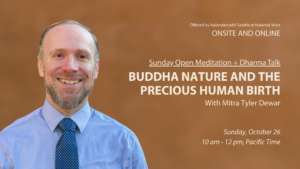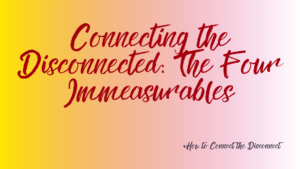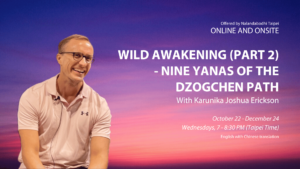On a sunny spring day this past March, I sat down on a rock next to Green Lake in Seattle to eat my lunch. I was not alone as there were two ducks sleeping a few feet away. I was surprised that I could move slowly, carefully, and mindfully enough to continue to share the space with them. I opened my lunch and started eating, and was pleasantly surprised to watch my mind settle, observing the landscape in front of and inside of me.
I noticed a crow attack the resting ducks, yet afterwards, the ducks swam off pretty peacefully. I then watched the crow dig where the pair had been lying. I witnessed fear come up in my mind and body when I heard rustling from a nearby bush and prepared to see a rat, and then noticed my body relax, with a sigh of relief and a slight smile, when I saw that it was a furry squirrel instead. I threw him a corn chip and watched him eat it, and listened to his crunches, a surprisingly soothing sound. I watched ducks speed up in the water and attack other ducks, which then swam quickly away, flapping their wings after the showdown.
I smiled and felt fortunate to have had many minutes where my mind felt more at ease than usual, and I could be in tune with the beautiful display of appearances in front of me, present to the sentient beings I saw in the landscape of the lake and trees. I was aware and present enough, not caught up in thoughts and emotions, to be witnessing life, in the moment. I thought to myself, “How wonderful it would be to live constantly mindful and aware!”
During Nalandabodhi’s recent 2021 retreat, “Be Wise, Go Kind: Joy on the Path of Resilience,” my teacher, Dzogchen Ponlop Rinpoche, said, “Life is beautiful, and at the end, life is just a moment. It is this moment.” Another dear teacher recently told me that we can only live fully and be free in the present moment.
But what does that mean? We can only “exist” in the present moment — we’re already there. According to my teachers and other Buddhist masters, there is only this very moment, and it is only in this moment that we can wake up. Now! But what exactly is this moment?
In some Buddhist traditions, it is said that a moment is measured as about 1/64th of a finger snap. In the appendix to her book, A Tale For the Time Being, author and Zen Buddhist priest Ruth Ozeki writes that, in a dream, the Zen nun Jiko Yasutani tried to explain what a moment is. The nun told Ozeki that if you were to start snapping consciously and snapped 98,463,077 times, which equals about one day, “you will experience the truly intimate awareness of knowing exactly how you spent every single moment of a single day of your life.”
Sometimes, I love the precise numbering and counting of moments as a way to focus my mind and to get to know what the present moment might actually be. Knowing this present moment more intimately may give us a better understanding of why, as Rinpoche says, “life is beautiful,” and how we can live fully and freely in it, and be more helpful to others.
If you, too, are curious about the present moment, you might want to experiment with finger snapping during a short meditation/contemplation. Once you get used to the practice, you can try experimenting with it anywhere, anytime!
Contemplative exercise:
- Sit on a cushion or chair somewhere quiet. Start by doing some calm abiding meditation by simply following the breath in and out. Many meditation instructors suggest bringing your awareness to your breath in order to be present because the breath is this present moment; breathing in and out can only happen in the present moment, not in the past or the future. Once settled, contemplate the following:
- Try to become aware of how fast a moment might be. Can you be in touch with how fast each moment is flying by? Try snapping a few times and contemplating how many moments pass in just one finger snap. Can you become more intimately aware of some moments? How about this moment?
- If you observe something new, let go of the contemplation and just relax for a few more moments before ending the session. You could try this practice a few times a day for a few days and see what you notice, and how it makes you feel.
Finally, I’d like to offer a quote from Lao Tzu, the Chinese philosopher, that one of my teachers recently shared:
“If you’re depressed, then you’re living in the past. If you’re living in anxiety, then you’re living in the future. If you’re living in peace, then you’re living in the present.”

Shana Fletcher is a resident at the Nalanda West Three Paths program in Seattle, Washington. Having recently graduated with a Bachelor of Arts degree in philosophy from Smith College, she decided to join the Three Paths residential program in order to deepen her study and practice of Buddhism. She has attended Nitartha Institute since 2018, and is interested in health and wellness, with an emphasis on the Asian healing arts.






